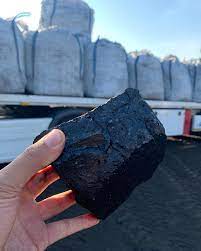Introduction:
As industries continue to embrace sustainability and eco-friendly practices, the demand for environmentally responsible materials has grown significantly. Among the materials that have been gaining attention for their environmental benefits is Gilsonite, a naturally occurring hydrocarbon resin. Gilsonite is primarily used in applications such as asphalt modification, drilling fluids, coatings, and paints, offering a range of benefits in terms of performance, longevity, and cost-effectiveness. What sets Gilsonite apart from other materials is its natural origin and its relatively low environmental impact when compared to synthetic alternatives. This article will delve into the environmental impact of Gilsonite, how it is extracted sustainably, and the benefits of using this eco-friendly material in various industries.
What is Gilsonite?
Gilsonite, also known as natural bitumen or asphaltite, is a naturally occurring material derived from the earth’s crust. It is a black, highly viscous resin that is primarily found in surface mines in regions like Utah in the United States. Unlike petroleum-based products, which are extracted from deep underground reserves, Gilsonite is mined through surface mining techniques, making it an inherently more sustainable option compared to other hydrocarbon products.
Gilsonite has been used for over a century as a performance-enhancing additive in various industrial applications. Its high melting point, thermal stability, and resilience make it an ideal modifier in products like asphalt, paints, coatings, and rubber. Additionally, because it is naturally sourced and does not rely on deep drilling or significant chemical processing, Gilsonite offers a more eco-friendly alternative to other petroleum-derived products.
Sustainable Mining of Gilsonite
The mining of Gilsonite is conducted using surface mining techniques, which have a lower environmental impact compared to traditional underground mining methods. Surface mining involves removing the topsoil and extracting the Gilsonite directly from the surface of the earth, rather than drilling deep into the ground. This process is more efficient and results in less land disturbance than underground mining.
1. Lower Environmental Disruption
One of the key benefits of surface mining is that it typically results in less environmental disruption. Traditional underground mining often involves large-scale excavation, drilling, and tunneling, which can disrupt ecosystems, contaminate water supplies, and cause significant damage to the surrounding environment. In contrast, surface mining for Gilsonite is a relatively non-invasive process.
After the mining process, the land is usually rehabilitated to restore the natural landscape. Gilsonite mining companies are required to follow strict environmental regulations and ensure that the land is restored to its original state once mining operations are complete. This rehabilitation process helps to mitigate the environmental impact and ensure that the mining operations are sustainable.
2. Reclamation and Land Restoration
Once the mining of Gilsonite is completed, the land is subject to reclamation efforts. These efforts are designed to return the mined areas to their natural state. The process includes:
- Replanting vegetation to restore natural habitats
- Restoring soil quality and reducing erosion
- Ensuring water quality is maintained in nearby streams and rivers
These efforts help to ensure that the environmental footprint of Gilsonite mining is minimized and that the surrounding ecosystem is returned to a healthy and productive state.
3. Eco-Friendly Transportation and Logistics
Gilsonite is typically transported via rail or truck, and the logistics associated with its transport are designed to be energy-efficient. By using efficient transportation methods, the environmental impact of transporting Gilsonite is minimized. Furthermore, bulk transportation of the material allows for a reduction in the carbon footprint associated with its delivery.
The Environmental Benefits of Using Gilsonite
Beyond its sustainable mining practices, Gilsonite offers a range of environmental benefits when used in various industries. Here are some key reasons why Gilsonite is considered an eco-friendly material:
1. Non-Toxic and Biodegradable
Unlike many synthetic chemicals and petroleum-based products, Gilsonite is non-toxic and biodegradable. This makes it a safer option for industries that need to consider the potential environmental impact of the materials they use.
For example, when Gilsonite is used in asphalt, paints, or coatings, it does not release harmful chemicals into the environment. This is in stark contrast to many synthetic alternatives that contain volatile organic compounds (VOCs), which can contribute to air pollution and negatively affect human health and the environment.
In addition, because Gilsonite is biodegradable, it will naturally break down over time without harming the surrounding ecosystem.
2. Reduced Carbon Footprint
By using Gilsonite, industries can help to reduce their carbon footprint. Gilsonite-modified products, such as asphalt, are more durable and require less frequent maintenance and repairs. This means that roads, for example, will have a longer lifespan, which reduces the need for additional resources to maintain or replace them. In turn, this helps to lower greenhouse gas emissions associated with manufacturing, transportation, and maintenance.
Moreover, Gilsonite’s long-lasting performance in asphalt and coatings contributes to overall resource conservation. Fewer repaving projects and repairs mean that less energy and fewer materials are required to maintain roads and other infrastructure, leading to a reduction in overall environmental impact.
3. Sustainable Infrastructure
When used in the construction of roads and infrastructure, Gilsonite helps to create sustainable systems that last longer and are more resilient to the effects of climate change. For instance, Gilsonite-modified asphalt is more resistant to high temperatures, weathering, and oxidation, making it an ideal choice for regions that experience extreme weather conditions.
As cities and governments around the world invest in green infrastructure and sustainable construction practices, Gilsonite is becoming an increasingly popular choice for enhancing the performance and sustainability of infrastructure projects.
Gilsonite and the Circular Economy
Another key environmental benefit of Gilsonite is its role in the circular economy. The circular economy model focuses on maximizing the use of resources and minimizing waste. Gilsonite is a highly versatile material that can be repurposed in a variety of ways without losing its effectiveness. For example, once a road constructed with Gilsonite-modified asphalt reaches the end of its life cycle, the material can be recycled and reused in the production of new asphalt.
Additionally, because Gilsonite is non-toxic and does not break down into harmful chemicals, it can be safely repurposed in a wide range of industries without causing environmental harm.
Conclusion
In conclusion, Gilsonite offers numerous environmental benefits that make it a highly sustainable choice for industries ranging from asphalt modification to paints and coatings. Its environmentally friendly properties, such as being non-toxic, biodegradable, and sustainable, make it a safer and more eco-friendly alternative to many synthetic materials.
The sustainable mining techniques used to extract Gilsonite, coupled with its role in reducing the carbon footprint of industries, underscore its environmental advantages. Furthermore, its long-lasting performance and ability to contribute to the circular economy make Gilsonite an important material in the transition toward more sustainable industrial practices.
As global demand for sustainable materials continues to grow, Gilsonite is well-positioned to play a significant role in eco-friendly innovation and sustainable development across multiple industries. By utilizing Gilsonite, industries can reduce their environmental impact while simultaneously improving the performance and longevity of their products.



